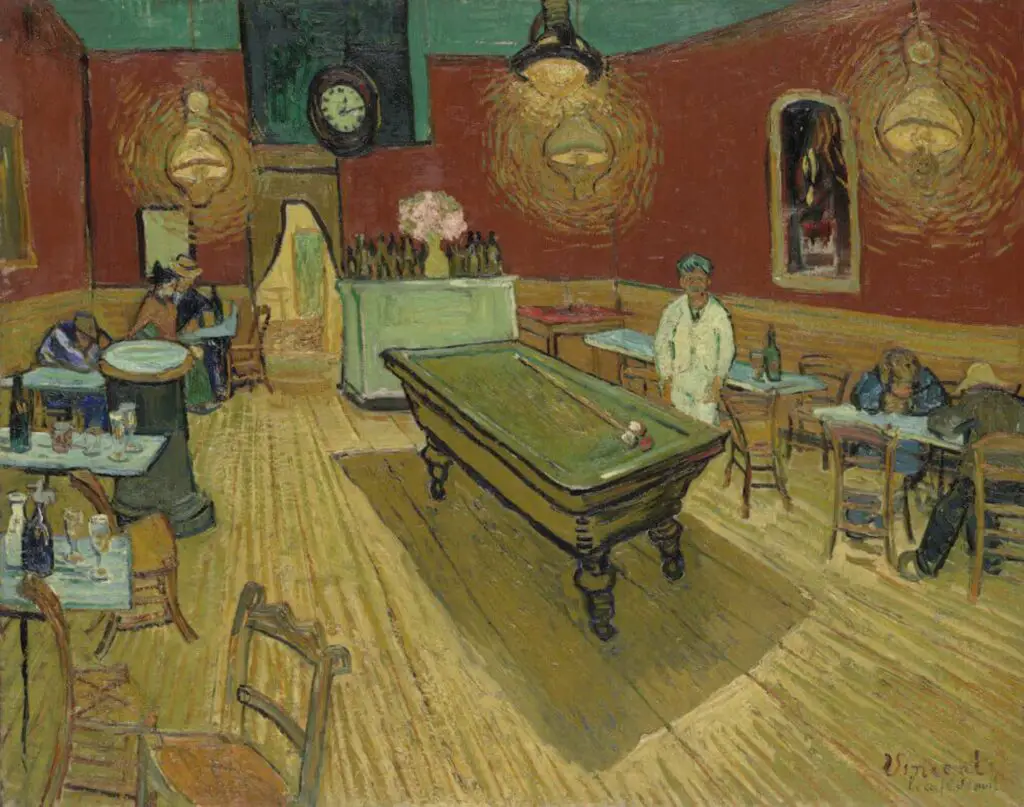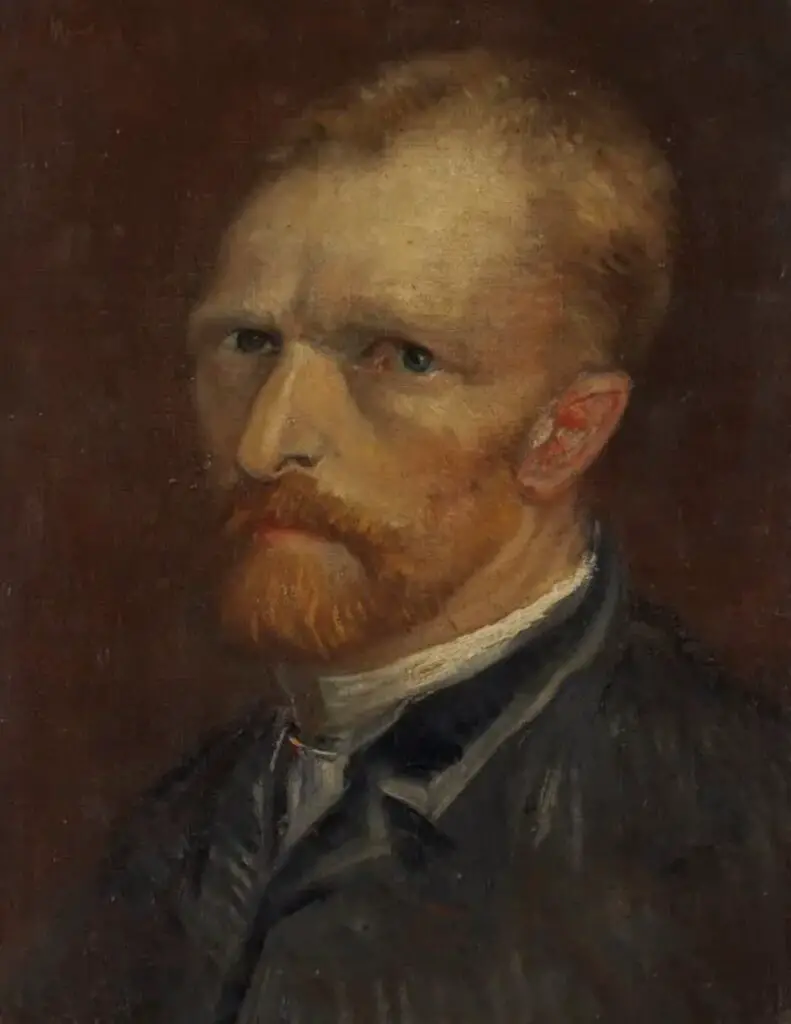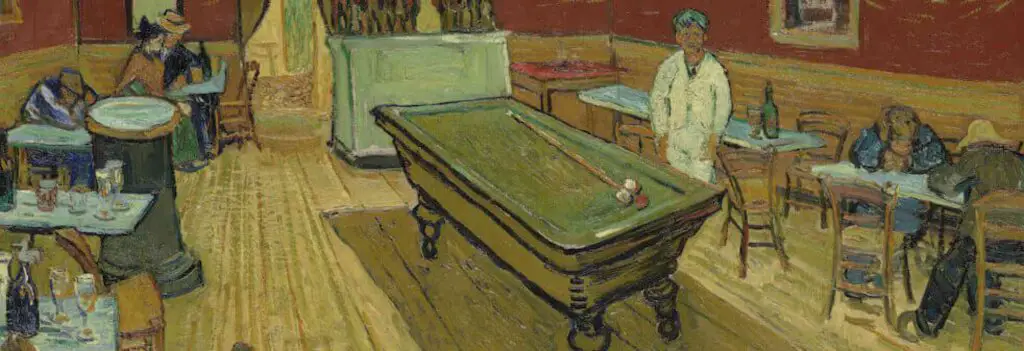Vincent van Gogh undoubtedly holds a position of immense significance in art history. His work includes some of the most iconic and influential paintings ever created.
Among these masterpieces lies “The Night Café,” a painting distinguished by its exceptional qualities, including its distinctive color palette, unique perspective, and the intriguing characters it portrays. Join us as we delve into the world of Vincent van Gogh’s “The Night Café” and uncover the reasons behind its enduring importance in art.
Table of Contents
- The Night Café by Vincent van Gogh: A Dive Into The Depths Of Despair
- The Setting Of “The Night Café”
- Perspective Of The Night Cafe: A Powerful Tool
- Frequently Asked Questions
- Related Questions
The Night Café by Vincent van Gogh: A Dive Into The Depths Of Despair
Vincent van Gogh, one of art history’s most iconic and influential painters, left a legacy of masterpieces that continue to captivate and bewitch art enthusiasts worldwide. Among his striking works, “The Night Café” is a haunting portrayal of a nocturnal world teetering on the edge of chaos and despair.

Read on as we embark on a journey to explore the profound and unsettling dimensions of this masterpiece, delving into the life of the artist and the eerie atmosphere of the café that inspired this iconic painting.
The Artist Vincent Van Gogh And His Creation- The Night Cafe

Vincent van Gogh, born in 1853 in the Netherlands, was a painter whose life was marked by passion, creativity, and inner turmoil. His artistic journey was a relentless quest for self-expression, often tinged with mental health challenges. In September 1888, Van Gogh found himself in the vibrant town of Arles, where he created “The Night Café” as an artistic response to the world around him.
The Setting Of “The Night Café”
“The Night Café” invites us into a haunting and unsettling interior scene. Van Gogh painted this masterpiece on a canvas measuring 30, a French standard size. The painting depicts a café interior, with a half-curtained doorway in the background, suggesting more private quarters beyond.
The composition is meticulously detailed, with five customers seated at tables along the left and right walls and a waiter, clad in a light coat, standing near a billiard table in the center of the room, facing the viewer.
The Characters In The Café

The five customers depicted in the scene have been described as three drunks and derelicts in a large public room huddled down in sleep or stupor.
This eerie depiction suggests the café was a gathering place for distressed local individuals, including down-and-outs and prostitutes. The atmosphere is desolate, capturing life’s stark realities on the margins.
A World Of Contrasting Colors
One of the most striking aspects of “The Night Café” is the vivid and contrasting use of colors. The ceiling is painted green, the upper walls are rendered red, and the gas ceiling lamps and floor are predominantly yellow.
Van Gogh applied the paint thickly, creating a rich and textured surface. The ceiling lamps emit an eerie glow, surrounded by orange-and-green halos contributing to the unsettling ambiance.
The Oppressive Combination Of Colors
The combination of red and green on the walls and ceiling creates an “oppressive combination,” while the lamps are described as “sinister features.” The painting’s top half sets the overall mood, evoking a sense of unease and foreboding.
The thickness of the paint adds a surreal quality, introducing waviness to the table tops, the billiard table, and the floor. The overall effect is a dispiriting and ominous atmosphere that lingers in the viewer’s mind.
Perspective Of The Night Cafe: A Powerful Tool
Critics have noted that the perspective in “The Night Café” is one of its most potent and impactful elements. The painting employs an absorbing perspective that draws the viewer deep into the scene.

The converging lines of the floorboards and billiard table propel us toward a mysterious, half-curtained doorway in the distance. This perspectival rush imparts a sense of vertigo and distorted vision, akin to the sensations experienced in nightmares.
A Journey Into Despair Of Night Life
“The Night Café” compels viewers to confront the underbelly of existence, inviting them to navigate a world of darkness, anguish, and despair. Van Gogh’s use of perspective, color, and texture creates a visual narrative that mirrors his inner struggles and the tumultuous emotions that plagued him throughout his life.
Vincent van Gogh’s “The Night Café” is a testament to the power of art to convey the complexities of human existence. It serves as a haunting reflection of the artist’s inner turmoil and the stark realities of a world on the fringes of society.
This masterpiece continues to captivate viewers with its enigmatic and unsettling atmosphere, leaving an indelible mark on the world of art and our collective consciousness.
As we contemplate the red and green walls, the eerie lamps, and the mysterious doorway, we are reminded of the profound impact that art can have in evoking emotions, sparking introspection, and illuminating the hidden corners of the human experience.
Anita Louise Art is dedicated to art education, great artists, and inspiring others to find and create their art. We love art that uplifts and inspires. #ArtToMakeYouSmile! #ArtToMakeYouHappy!
If you want to see any of my art, you can find out more by clicking here. If you are interested in what inspires me and my paintings, you can discover more by clicking here.
We have a free newsletter and would love you to be part of our community; you can subscribe to the newsletter by clicking here. If you have any questions, I would be happy to talk to you anytime. You can reach me, Anita, by clicking here.
Subscribe to our Anita Louise Art YouTube Channel with great videos and information by clicking here.
Join us for our podcast “5 Minutes With Art.” Spend just 5 minutes a week with us to discover and learn about great art and artists. You can find out more about our podcast by clicking here.
Frequently Asked Questions
What is “The Night Café” by Vincent van Gogh?
“The Night Café” is a renowned painting created by Vincent van Gogh in 1888. It is celebrated for its vivid colors, emotional intensity, and distinctive portrayal of a café interior. The painting is housed in the Yale University Art Gallery.
What inspired Vincent van Gogh to paint “The Night Café”?
Van Gogh was inspired to paint “The Night Café” based on his personal experiences and observations. He aimed to convey the atmosphere of the night and the emotions associated with it.
Why is the color palette of “The Night Café” so distinctive?
The painting’s vibrant and contrasting color palette, featuring bold reds, greens, and yellows, is characteristic of van Gogh’s unique style. The intense colors are believed to reflect the artist’s emotional state and convey the intense atmosphere of the scene.
What is the significance of the perspective in “The Night Café”?
Van Gogh employed a skewed and distorted perspective in “The Night Café” to create a sense of unease and disorientation. This intentional distortion contributes to the emotional impact of the painting.
Who are the characters depicted in “The Night Café”?
The painting portrays various individuals in a café setting, each seemingly absorbed in their own thoughts. The characters add a layer of mystery to the scene, inviting viewers to interpret their emotions and relationships.
How does “The Night Café” reflect van Gogh’s mental state?
Vincent van Gogh’s mental struggles are often reflected in his art. Some art historians suggest that the turbulent emotions and distorted perspective in “The Night Café” may offer insights into van Gogh’s mental and emotional turmoil during the time of its creation.
What is the symbolism behind the objects in the painting?
Objects within the café, such as the pool table and the clock, are thought to hold symbolic meaning. Interpretations vary, but some believe they represent the passage of time, life’s transience, and the inevitability of change.
How did contemporary audiences and critics respond to “The Night Café”?
Upon its creation, “The Night Café” did not receive widespread acclaim. Some critics found its unconventional style and vibrant colors unsettling. However, over time, the painting has come to be regarded as a masterpiece, appreciated for its innovative approach.
How does “The Night Café” contribute to van Gogh’s body of work?
“The Night Café” is considered a pivotal work in van Gogh’s career, showcasing his evolving style and experimentation with color and form. It stands out as a testament to his commitment to expressing emotion through art.
What is the legacy of “The Night Café” in the art world?
“The Night Café” remains a celebrated and studied work in art history. Its influence can be seen in the works of subsequent artists, and its enduring popularity attests to its significance in the canon of art.
Related Questions
What Was The Focus Of Renaissance Art?
The focus of Renaissance art was on the classics of Greek and Rome, humanist philosophy, and the study of the human figure. Realism was also an essential part of renaissance art. The great artists of the Renaissance also became great anatomists and studied human beings.
By clicking here, you can learn more by reading What Was The Focus Of Renaissance Art?
What Is The Importance Of Art From The Renaissance Period?
Renaissance art is essential as it was a time of rebirth and discovery. Artists like Leonardo da Vinci, Michelangelo, and Raphael were at the forefront of that change, creation, and discovery. Renaissance art has influenced art and artists for many centuries and continues to influence artists today.
By clicking here, you can learn more by reading What Is The Importance Of Art From The Renaissance Period?
Did Leonardo da Vinci Believe In God?
Leonardo did not tell us what his belief in God was, but there is evidence that is left that suggests that he held fast to many Christian ideals and beliefs. People such as the artist and author Giorgio Vasari, who knew him and wrote about him, spoke of his character and what a great man he was.
By clicking here, you can learn more by reading Did Leonardo da Vinci Believe In God?


